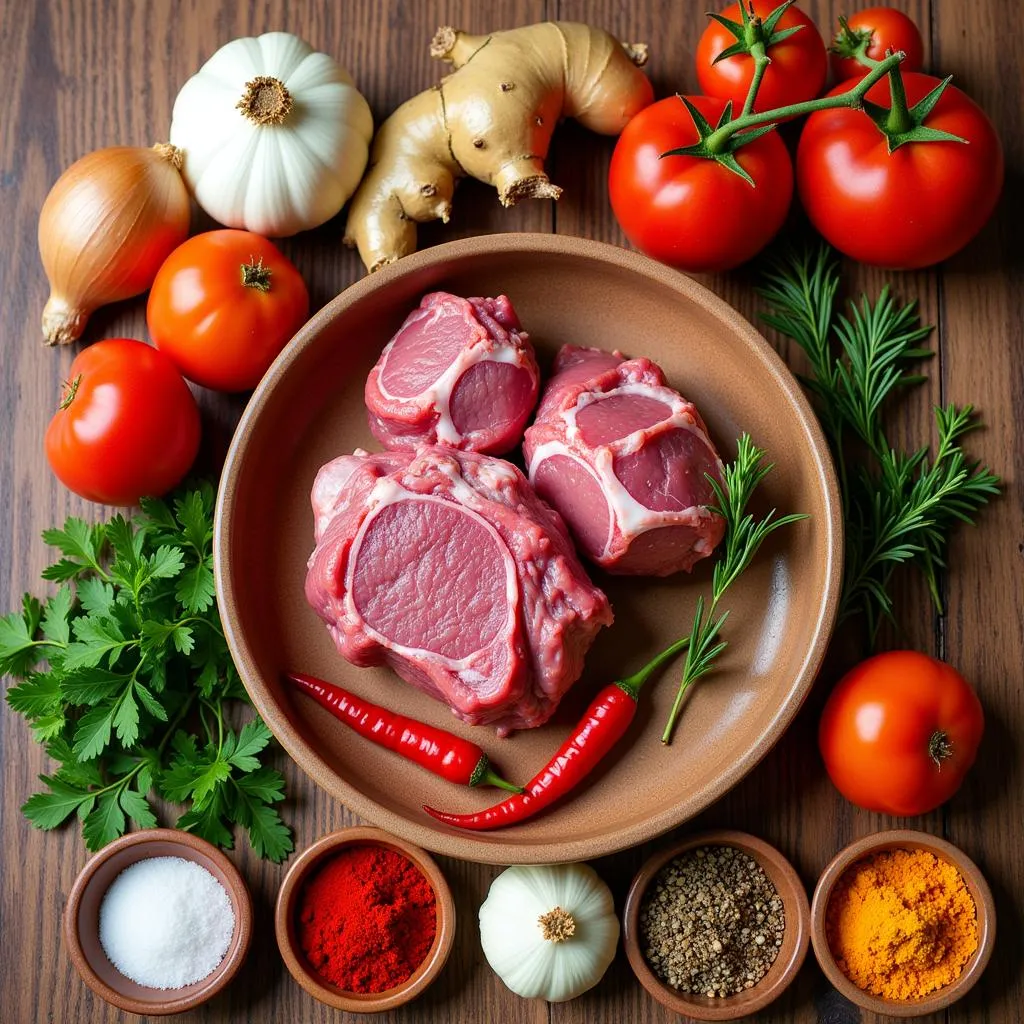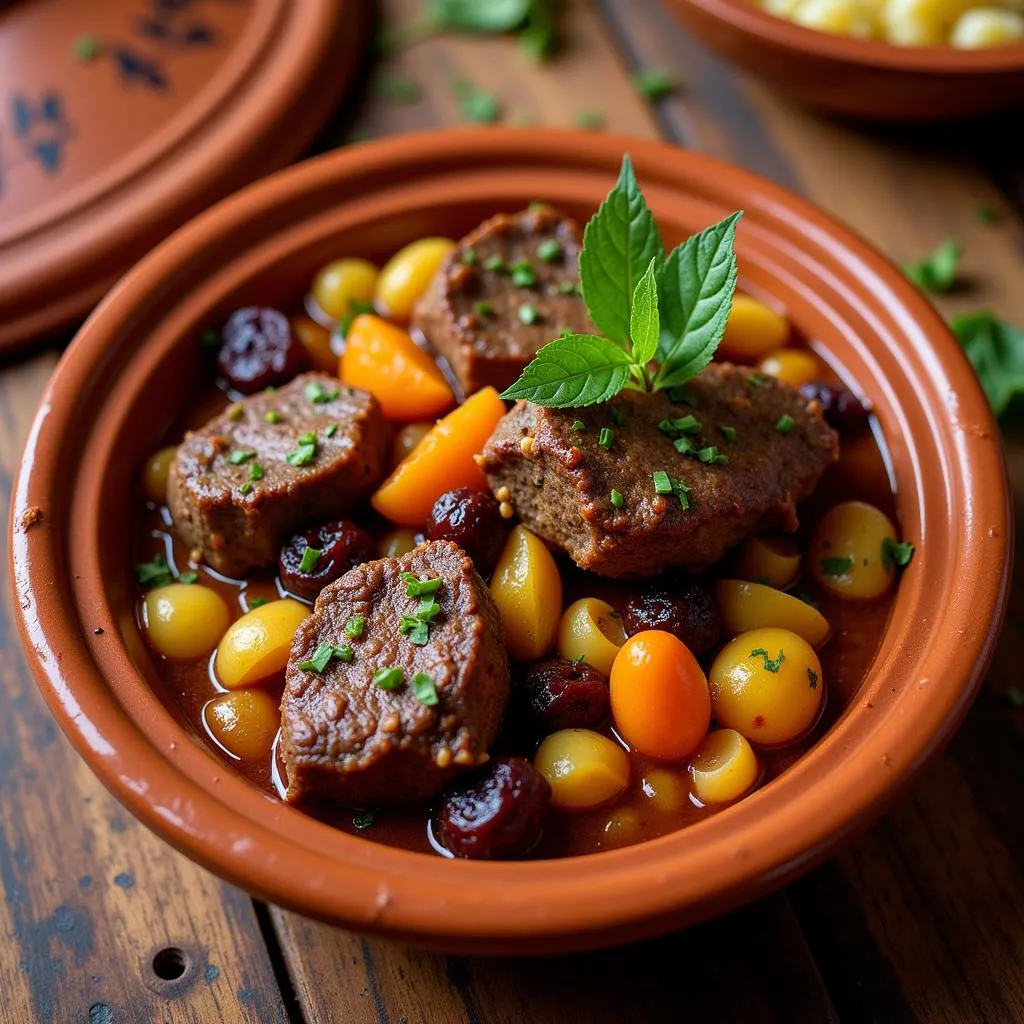Exploring the Rich Flavors of African Lamb Stew
African Lamb Stew is a culinary adventure that takes you on a tantalizing journey through the diverse flavors of the continent. From the aromatic spices of North Africa to the hearty stews of West Africa, each region boasts its own unique interpretation of this classic dish. In this article, we’ll delve into the history, ingredients, and cultural significance of African lamb stew, exploring its variations across different countries and providing you with a recipe to recreate the magic in your own kitchen.
A Culinary Tapestry: The Origins and Evolution of African Lamb Stew
The history of African lamb stew is intertwined with the history of the continent itself. Nomadic tribes, traveling across vast landscapes, relied on slow-cooking methods to tenderize tough cuts of meat. Lamb, with its availability and adaptability to various flavors, became a staple ingredient in these stews. As trade routes flourished, spices and ingredients from different regions were introduced, enriching the flavor profiles of these dishes.
Over centuries, African lamb stew evolved into a melting pot of culinary influences. The Berbers of North Africa introduced the use of aromatic spices like cumin, coriander, and saffron, while the West African coast was influenced by the flavors of palm oil, peanuts, and chilies brought by Portuguese traders. Each region added its own unique touch, resulting in a diverse array of stews that reflect the cultural heritage and culinary creativity of the African people.
 Aromatic spices and fresh ingredients for African lamb stew
Aromatic spices and fresh ingredients for African lamb stew
A Symphony of Flavors: Key Ingredients in African Lamb Stew
While the specific ingredients vary depending on the region, certain staples are found in almost all African lamb stews. Lamb, of course, is the star of the show, providing a rich and flavorful base for the stew. Tomatoes, onions, and garlic form the aromatic foundation, while ginger, chilies, and a blend of spices like cumin, coriander, and turmeric add depth and complexity.
Many stews also incorporate vegetables like potatoes, sweet potatoes, carrots, and greens, adding both texture and nutritional value. The choice of liquid also varies, with some recipes using water or stock, while others opt for coconut milk or peanut butter for a richer, creamier texture.
A Journey Through Flavors: Regional Variations of African Lamb Stew
From the spice-infused tagines of Morocco to the hearty peanut stews of West Africa, the variations of African lamb stew are as diverse as the continent itself.
North Africa: In Morocco, lamb stew is known as “tagine” and is typically cooked in a conical earthenware pot of the same name. The stew is often flavored with exotic spices like saffron, cinnamon, and preserved lemons, and is served with fluffy couscous.
West Africa: In countries like Senegal and Ghana, groundnut stew is a popular variation, featuring a rich and creamy sauce made with peanut butter, tomatoes, and spices. This stew is often served with rice or fufu, a starchy side dish made from boiled and mashed root vegetables.
East Africa: In Ethiopia and Eritrea, lamb stew is known as “wat” and is characterized by the use of berbere, a complex spice blend that includes chili peppers, garlic, ginger, and fenugreek. The stew is often served on top of injera, a spongy flatbread made from teff flour.
South Africa: In South Africa, lamb stew is known as “bredie” and is a slow-cooked dish that typically includes vegetables like potatoes, carrots, and green beans. The stew is often flavored with Cape Malay spices like turmeric, coriander, and cumin.
 A traditional Moroccan tagine with tender lamb and vibrant vegetables.
A traditional Moroccan tagine with tender lamb and vibrant vegetables.
Cooking Up a Feast: A Classic African Lamb Stew Recipe
Now that we’ve explored the rich history and diverse flavors of African lamb stew, let’s try our hand at creating a classic recipe that captures the essence of this beloved dish.
Ingredients:
- 1 kg lamb, cut into cubes
- 2 tablespoons olive oil
- 1 large onion, chopped
- 4 cloves garlic, minced
- 1 inch ginger, minced
- 1 teaspoon ground cumin
- 1 teaspoon ground coriander
- 1/2 teaspoon turmeric
- 1/4 teaspoon cayenne pepper
- 1 (14.5 ounce) can diced tomatoes, undrained
- 1 cup beef broth
- 1 cup water
- 2 large potatoes, peeled and cubed
- 1 cup chopped carrots
- 1/2 cup chopped fresh cilantro, for garnish
Instructions:
- In a large pot or Dutch oven, heat olive oil over medium heat. Brown lamb on all sides.
- Add onion, garlic, and ginger to the pot and cook until softened, about 5 minutes.
- Stir in cumin, coriander, turmeric, and cayenne pepper and cook for 1 minute, until fragrant.
- Add diced tomatoes, beef broth, and water to the pot. Bring to a boil, then reduce heat and simmer for 1 hour, or until lamb is tender.
- Add potatoes and carrots to the pot and simmer for an additional 30 minutes, or until vegetables are tender.
- Season with salt and pepper to taste.
- Serve hot, garnished with fresh cilantro.
African Lamb Stew: A Culinary Tradition That Transcends Borders
African lamb stew is more than just a meal; it’s a culinary tradition that reflects the history, culture, and hospitality of the African people. Whether it’s a fragrant tagine in Morocco or a hearty peanut stew in Ghana, this dish is a testament to the ingenuity and culinary prowess of African cooks.
So, the next time you’re looking for a flavorful and exotic dish to impress your guests, look no further than African lamb stew. With its rich history, diverse flavors, and ease of preparation, it’s a guaranteed crowd-pleaser that will transport your taste buds to the heart of Africa.
Frequently Asked Questions about African Lamb Stew
-
What type of lamb is best for African lamb stew?
Shoulder or leg of lamb are good choices for stew as they are flavorful and become tender when cooked slowly.
-
Can I make African lamb stew in a slow cooker?
Absolutely! Simply brown the lamb in a skillet before transferring it to the slow cooker. Add the remaining ingredients and cook on low for 6-8 hours, or until the lamb is fall-apart tender.
-
What are some common side dishes served with African lamb stew?
Popular side dishes include rice, couscous, fufu, injera, and ugali.
-
Can I freeze African lamb stew?
Yes, African lamb stew freezes well. Allow it to cool completely before transferring it to airtight containers and freezing for up to 3 months.
-
Where can I find authentic African spices?
Specialty grocery stores and online retailers are great resources for finding African spices. You can also check local African markets or restaurants.
 A family enjoying a traditional meal of African lamb stew.
A family enjoying a traditional meal of African lamb stew.
If you’re looking to explore more of Africa’s culinary delights, check out our articles on African cuisine history and traditional South African food. For those interested in other African lamb dishes, we have a dedicated article on African lamb dishes. And if you’re ever in Nairobi, be sure to check out our recommendations for the best African dishes Nairobi has to offer. Don’t miss out on our article about African groundnut soup, a must-try West African delicacy.
Need more assistance in planning your African culinary adventure? Contact us at Phone Number: +255768904061, Email: kaka.mag@gmail.com or visit our address: Mbarali DC Mawindi, Kangaga, Tanzania. We have a 24/7 customer service team ready to assist you.



